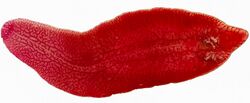Biology:Neodermata
| Neodermata | |
|---|---|

| |
| Fasciola hepatica, a neodermatan | |
| Scientific classification | |
| Domain: | Eukaryota |
| Kingdom: | Animalia |
| Phylum: | Platyhelminthes |
| Subphylum: | Rhabditophora |
| Superclass: | Neodermata Ehlers, 1985 |
| Orders | |
Neodermata is a clade of rhabditophoran flatworms containing the parasitic groups Trematoda, Monogenea and Cestoda.
Description
All neodermatans are parasites, in many groups having a free-swimming larval stage. The most striking feature uniting all neodermatans is that the ciliated epidermis (typical of most flatworms) is cast off in adult worms, being replaced by a syncytium called tegument or neodermis. Other characters found in all neodermatans are related to the anatomy of the protonephridium and the rootlets of epidermal locomotory cilia.[1]
Phylogeny
Currently, the monophyly of Neodermata is undisputed, being supported by both morphological and molecular data.[2] It is clear that they evolved from free-living flatworms (turbellarians), but their sister-group was for a long time a matter of debate. The first attempts to reconstruct the phylogeny of flatworms, based on morphological evidence, considered Rhabdocoela to be the sister-group of Neodermata, but this was based on weak morphological similarities and was not supported by molecular studies.[3]
The most recent evidences put the order Bothrioplanida as the sister-group of Neodermata, uniting them in a clade called Bothrioneodermata.[3]
References
- ↑ Rohde, K. (1990). "Phylogeny of platyhelminthes, with special reference to parasitic groups". International Journal for Parasitology 20 (8): 979–1007. doi:10.1016/0020-7519(90)90041-K. ISSN 0020-7519. PMID 2074143.
- ↑ Littlewood, D. T. J.; Rohde, K.; Bray, R. A.; Herniou, E. A. (1999). "Phylogeny of the Platyhelminthes and the evolution of parasitism". Biological Journal of the Linnean Society 68 (1–2): 257–287. doi:10.1111/j.1095-8312.1999.tb01169.x. ISSN 0024-4066.
- ↑ 3.0 3.1 Egger, B.; Lapraz, F.; Tomiczek, B.; Müller, S.; Dessimoz, C.; Girstmair, J.; Škunca, N.; Rawlinson, K. A. et al. (2015). "A transcriptomic-phylogenomic analysis of the evolutionary relationships of flatworms". Current Biology 25 (10): 1347–1353. doi:10.1016/j.cub.2015.03.034. PMID 25866392.
Wikidata ☰ Q150983 entry
 |

